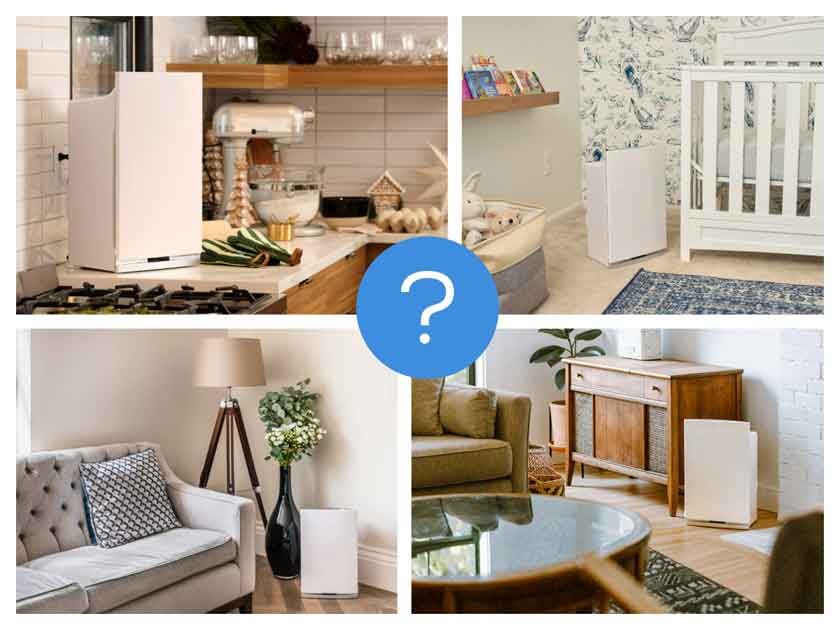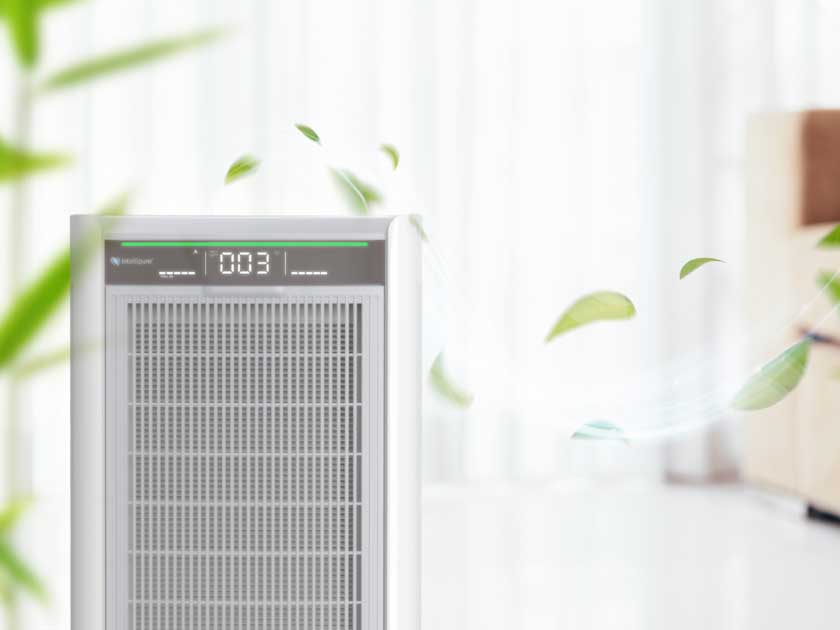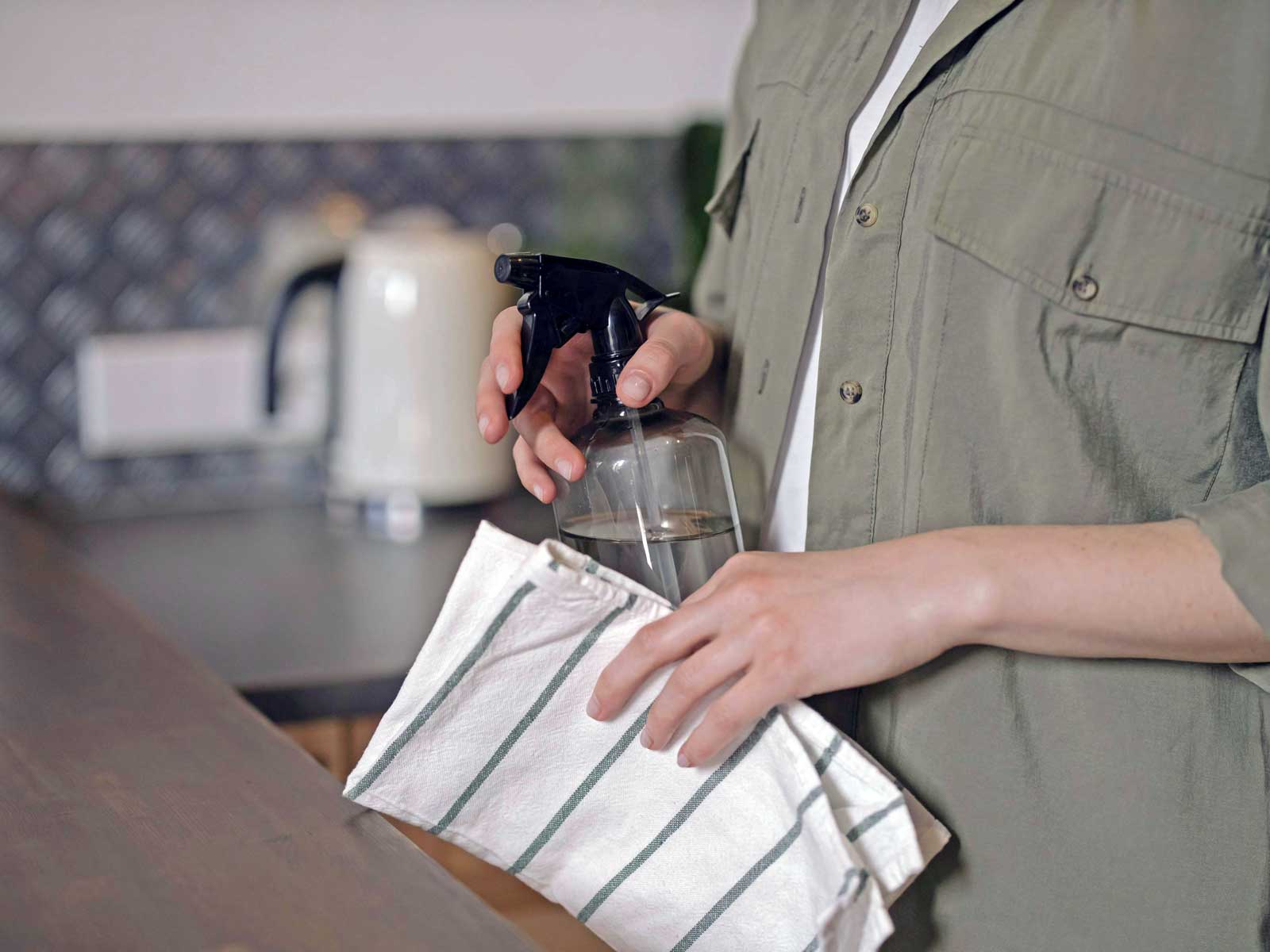
Summary
- Place portable air purifiers in the center of a room, 3–5 feet off the ground, to optimize airflow and clean the air you breathe.
- Keep air purifiers clear of obstructions, walls, electronics, and heat sources to maintain efficiency and proper CADR performance.
- Use multiple air purifiers or a whole-home system in large or multi-story homes to ensure complete coverage and targeted air cleaning.
- Control moisture and humidity to prevent filter damage, mold growth, and reduced purifier efficiency.
- Target pollution sources directly, such as kitchens, basements, or bedrooms, while maintaining proper air circulation and regular filter maintenance.
Now that you have your new air purifier, it is time to put it to work. But where exactly should you place it? Since an air purifier works best when it can circulate air efficiently, there are a few things to consider. Here’s a few best practices for choosing the perfect location for your air purifier for the best indoor air quality.
Focus on the Center
Ideally, the best place to put a portable air purifier is the center of the room on a platform three to five feet off the ground. This allows for optimal circulation and most efficient airflow. The center of the room also likely does not have any obstructions that could impede airflow. Clear space around the air purifier intake gives the fan easy access to air so it can work as efficiently as possible.
A whole-home air purifier should be integrated into the HVAC system. The Intellipure SuperV Whole Home Air Purifier unit is typically installed in the main inlet before the HVAC air handler. This allows it to clean all incoming air, while also keeping the furnace clean. The unit itself may be tucked away in a basement or attic, but placing it in the middle of the HVAC airflow allows it to distribute clean air across the entire home.
Placing the air purifier in a central area it is much more likely to capture pollutants at its rated clean air delivery rate (CADR). CADR measures how many cubic feet of air per minute that an air purifier can clean. Much like how a kitchen exhaust fan is most effective right over the stove, putting an air purifier in the middle of the room places it in the spot where it can do the most good.
Avoid Obstructions
An air purifier needs access to free airflow in order to work efficiently. Having a HEPA filter with an activated carbon filter is meaningless if the air purifier can’t move air through it. A portable air purifier should have three to five feet of clearance on all sides for best performance. It should be away from walls, furniture, heating radiators, or any other object that could interfere with air flow.
Nothing should be near the air purifier intake grille or exhaust vents. Blocking these air paths makes it harder for the intake fan/exhaust fan to move air through the filter. Make sure that curtains or drapes cannot accidentally block the air purifier intake.
It is also a good idea to keep electronic devices away from a portable air purifier. Since it draws dirty air, electronic devices near the intake may collect more dust than usual. Any air purifier that uses ionization should be kept away from electronics to prevent electrical interference.

Elevated Air Purifier Placement
Placing a portable air purifier above the ground is a smart idea. Most people breathe air between three to five feet off the floor, so putting the air purifier at that height helps clean the air people are actually breathing. This makes it more likely to catch harmful particles before they are inhaled.
Benefits of Elevated Placement
To achieve higher CADR numbers, the air purifier needs to be free to draw in and exhaust air as easily as possible. Putting it higher up in the room also helps with floor-to-ceiling cleaning efficiency. Lighter pollutants, like smoke, soot, and allergens, tend to float around in the upper parts of the room. Since ventilation isn’t always an option for improving indoor air quality, it is a good idea to make sure your air purifier location is optimized for top performance.
Air Purifier Locations
It is easy to get a portable air purifier up off the floor. You can use a table, shelf (just don’t put it directly against the wall), or dresser to elevate the device. There are wall-mountable air purifier options to save floor space or where clearance is tight. Consult the owner’s manual for proper clearance before mounting an air purifier on the wall. Ideally, it should be between three to five feet off the floor.
Higher Up, Less Clogging
There are other benefits to getting portable air purifiers up off the floor. First, it won’t be a tripping hazard, especially in the middle of the night. Being elevated also means the air purifier filters are less likely to be clogged by dirt and hair that should be picked up by the vacuum cleaner. Many portable air purifiers have a pre-filter which is designed to catch larger contaminates. Having the air purifier off the ground helps prevent the pre-filter from clogging up prematurely.
Room-By-Room Placement Suggestions
Just having a portable air purifier in a room will improve indoor air quality, but for optimal performance, the location should match the air cleaning needs. Keep in mind that the best location is always three to five feet off the floor for the best airflow. Here are a few suggestions on where to put an air purifier based on the room it is in:
Living Room
For a living room, den, or rec room, it is best to put the air purifier in a central location near the seating area where people gather. Keep it away from any obstructions like a sofa or bookshelf. Do not place it near the fireplace or any other sources of heat. It is also recommended to keep the air purifier away from electronics to prevent any possible interference. If there are high traffic entry points in the living room, having the air purifier nearby can help capture outdoor pollutants as they enter the home.

Bedroom
For a bedroom, it is best to have the air purifier near the bed. Placing a HEPA purifier on a nightstand works great. Make sure the intake or outlet isn't blocked by the wall or curtains. Ideally, place the air purifier away from any HVAC vents that could interrupt airflow. Avoid leaving windows open at night because sometimes outdoor air quality is actually worse.
Kitchen
For the kitchen, you want to place your air purifier near the source of the pollution. A countertop works well, but be sure it’s not close to a heat source which could damage the unit. If garbage smells are a problem and you have an air purifier with a VOC filter, place it nearby. Many houses have open floor plans with the kitchen in the same area as the living room or den. Depending on room size and layout, it may make sense to use more than one air purifier to clean the air effectively.
Even medical-grade HEPA filters can’t remove everything. Using an air purifier with activated carbon filters helps remove kitchen odors and any other wayward volatile organic compounds (VOCs) from cooking. The Intellipure Compact features a pre-filter that captures VOCs to make air fresher and cleaner. It is also wise to use other ventilation sources like a range hood to remove heat and cooking emissions from the room.
Basement
There can be a whole host of airborne contaminants in the basement. Place the air purifier on a table in the center of the space, making sure to pay attention to the unit’s square footage coverage. For large, open basements, you may need to use multiple air purifiers or a single large unit. If your basement is used as a kids play area, home office, or home gym, position the air purifier near the activities. One of the air quality concerns often found in basements is mold. If the basement has issues with high humidity, it is recommended to use a dehumidifier as well to keep down mold growth and mold spores.
An air purifier's CADR is based on unobstructed airflow, so it is extremely important to keep the surrounding area clear.
Watch Out for Water
High moisture levels can impact how your air purifier performs and potentially spread airborne pollutants. It is common sense to keep an electric air purifier away from water, but when that water is in the form of humidity in the air, it can be a bit more difficult.
Air Purifier Moisture Damage
An air purifier operating in moisture-prone areas can get damaged after prolonged moisture exposure. Electronics can corrode and rust may form leading to premature component wear or failure. Some smart air purifiers have delicate electronics which are sensitive to too much moisture and may malfunction.
In the worst case scenario, the air filter itself may become waterlogged. Instead of removing mold spores from the air, the now soaked air filter becomes a place for mold growth. Without proper humidity control, an air cleaner can turn into something that is quite the opposite. A waterlogged filter is also harder for air to flow through, adding unnecessary stress to the fan motor.
Reduced Air Purifier Efficiency
Air purifiers operating in high humidity areas will likely not perform as well as their CADR rating. If the air filter is wet, it will not work as effectively and will likely clog faster, shortening filter life. Depending on the air filter composition, the high moisture levels may cause fibers to swell or even fall apart.
Moisture Control Is Key
The first step in moisture management is to find the source of the water and stop it. Moisture-prone areas like basements and crawl spaces are especially notorious for unwanted water intrusions. Leaking pipes or roofs and even uncontrolled A/C condensation can all contribute to higher humidity levels. It is worth the time to track down the water leaks or hire a professional to resolve the issue. Once the water problem is solved, you can assess whether additional steps are needed. In some cases, using a dehumidifier is necessary for moisture management even if there are no water leaks. Pairing an air purifier with a dehumidifier can deliver excellent indoor air quality and comfort, especially in areas where high humidity is the norm.
Stopping Pollution at the Source
If possible, capture airborne pollution before it has a chance to spread. If an air pollution source can be identified, then placing an air purifier nearby is the next step.
Common Indoor Air Pollution Sources
Not all air pollution comes from outside; there are plenty of indoor air pollution sources as well. The kitchen stove is a major source of air pollutants such as VOCs and particulate matter. Tobacco smoke releases fine particulates, toxic chemicals, and VOCs. Building materials, carpet, furniture, and flooring can offgas volatile organic compounds like formaldehyde. Upholstery can be a source of tiny airborne fibers. Household cleaning products can give off harmful fumes. Any place with warm, damp air can harbor mold, which leads to mold spores. Since outdoor air pollution is eventually indoor air pollution, doors and windows are also pollution sources.
Targeting Pollution Sources
Make sure the air purifier air intake is pointed at the pollution source, but keep it away from any heat sources. Placing an air purifier with activated carbon filters in a freshly remodeled room can help remove gaseous pollutants and harmful fumes from cleaning chemicals. Putting an air purifier on the counter in the kitchen near the stove helps remove particulates and VOCs. It is still wise to use a ventilation source like an extractor hood whenever cooking over a stove.
Air Flow Is Important
Remember that air purifier CADR ratings are based on uninterrupted airflow, so make sure there is plenty of open space around the unit. Don’t place the air purifier near an air vent or any object that can interrupt clear air flow in and out of the unit. Change the air filters regularly to keep the air purifier operating efficiently.
Keep Tabs on Indoor Air Quality
There are several indoor air quality sensors and particle counters that can give you a real-time look at air quality. Since pollution concentrations can vary from one space to another, having more than one sensor can help you track down pollution sources.
Advantages of Using Multiple Air Purifiers
In some situations, it makes sense to integrate a whole-home air purifier with the existing HVAC system. For example, the Intellipure SuperV is installed directly in line with the HVAC duct where it can supply clean air throughout the entire home. But in other situations, it might be better to use multiple portable air purifiers. Smaller units can be positioned throughout the home in areas where they are needed the most.
Area Coverage
In large, complex, or odd-shaped spaces, using several air purifiers can help ensure adequate air cleaning capacity. Areas with limited airflow or poor air circulation can have a dedicated air purifier to keep the air fresh. Homes with open floor plans can position multiple air purifiers around to overlap coverage. For homes with multiple stories, having air purifiers upstairs and downstairs makes sure everyone in the house has clean air. A wall mountable air purifier is a great solution for areas with clearance space challenges. For advanced IAQ management, add a few air quality sensors around the house so you know exactly when and where you need air cleaning the most.
Flexibility
Having more than one air purifier is helpful when needs change. When a family member gets sick, you can move an air purifier to their bedroom to remove contagious airborne microorganisms. During parties or gatherings, an air purifier can be placed where it benefits the most people. If mold is found in the basement, an air purifier can help control mold spores.
Ease of Maintenance
Having more than one air purifier of the same type makes maintenance a snap. No more juggling different replacement filters, just keep one filter type on hand. If your air purifier has a washable pre-filter, you can keep one air purifier running, while maintaining the other so there is no gap in air cleaning.
Putting some thought into your air purifier placement will help ensure you get the most out of your clean air investment. No two situations are exactly the same, so try different air purifier locations to get the best results for your home.

 Intellipure Donates 1,000 Air Purifiers to ShelterBox USA for Altadena Fire Relief
Intellipure Donates 1,000 Air Purifiers to ShelterBox USA for Altadena Fire Relief
 What is Ragweed And Why Does It Cause So Much Trouble?
What is Ragweed And Why Does It Cause So Much Trouble?





